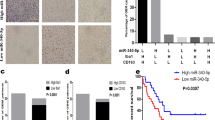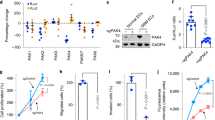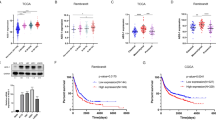Abstract
Tumor-associated macrophages (TAMs) originate as circulating monocytes, and are recruited to gliomas, where they facilitate tumor growth and migration. Understanding the interaction between TAM and cancer cells may identify therapeutic targets for glioblastoma multiforme (GBM). Vascular cell adhesion molecule-1 (VCAM-1) is a cytokine-induced adhesion molecule expressed on the surface of cancer cells, which is involved in interactions with immune cells. Analysis of the glioma patient database and tissue immunohistochemistry showed that VCAM-1 expression correlated with the clinico-pathological grade of gliomas. Here, we found that VCAM-1 expression correlated positively with monocyte adhesion to GBM, and knockdown of VCAM-1 abolished the enhancement of monocyte adhesion. Importantly, upregulation of VCAM-1 is dependent on epidermal-growth-factor-receptor (EGFR) expression, and inhibition of EGFR effectively reduced VCAM-1 expression and monocyte adhesion activity. Moreover, GBM possessing higher EGFR levels (U251 cells) had higher VCAM-1 levels compared to GBMs with lower levels of EGFR (GL261 cells). Using two- and three-dimensional cultures, we found that monocyte adhesion to GBM occurs via integrin α4β1, which promotes tumor growth and invasion activity. Increased proliferation and tumor necrosis factor-α and IFN-γ levels were also observed in the adherent monocytes. Using a genetic modification approach, we demonstrated that VCAM-1 expression and monocyte adhesion were regulated by the miR-181 family, and lower levels of miR-181b correlated with high-grade glioma patients. Our results also demonstrated that miR-181b/protein phosphatase 2A-modulated SP-1 de-phosphorylation, which mediated the EGFR-dependent VCAM-1 expression and monocyte adhesion to GBM. We also found that the EGFR-dependent VCAM-1 expression is mediated by the p38/STAT3 signaling pathway. Our study suggested that VCAM-1 is a critical modulator of EGFR-dependent interaction of monocytes with GBM, which raises the possibility of developing effective and improved therapies for GBM.
This is a preview of subscription content, access via your institution
Access options
Subscribe to this journal
Receive 50 print issues and online access
$259.00 per year
only $5.18 per issue
Buy this article
- Purchase on Springer Link
- Instant access to full article PDF
Prices may be subject to local taxes which are calculated during checkout










Similar content being viewed by others
References
Clarke J, Butowski N, Chang S . Recent advances in therapy for glioblastoma. Arch Neurol 2010; 67: 279–283.
Stupp R, Mason WP, van den Bent MJ, Weller M, Fisher B, Taphoorn MJ et al. Radiotherapy plus concomitant and adjuvant temozolomide for glioblastoma. N Engl J Med 2005; 352: 987–996.
Hambardzumyan D, Gutmann DH, Kettenmann H . The role of microglia and macrophages in glioma maintenance and progression. Nat Neurosci 2016; 19: 20–27.
Feng X, Szulzewsky F, Yerevanian A, Chen Z, Heinzmann D, Rasmussen RD et al. Loss of CX3CR1 increases accumulation of inflammatory monocytes and promotes gliomagenesis. Oncotarget 2015; 6: 15077–15094.
Mantovani A, Allavena P, Sica A, Balkwill F . Cancer-related inflammation. Nature 2008; 454: 436–444.
Germano G, Allavena P, Mantovani A . Cytokines as a key component of cancer-related inflammation. Cytokine 2008; 43: 374–379.
Crusz SM, Balkwill FR . Inflammation and cancer: advances and new agents. Nat Rev Clin Oncol 2015; 12: 584–596.
Maruno M, Kovach JS, Kelly PJ, Yanagihara T . Distribution of endogenous tumour necrosis factor alpha in gliomas. J Clin Pathol 1997; 50: 559–562.
Mantovani A . Cancer: an infernal triangle. Nature 2007; 448: 547–548.
Hussain SF, Yang D, Suki D, Aldape K, Grimm E, Heimberger AB . The role of human glioma-infiltrating microglia/macrophages in mediating antitumor immune responses. Neuro Oncol 2006; 8: 261–279.
Yeh WL, Lu DY, Liou HC, Fu WM . A forward loop between glioma and microglia: glioma-derived extracellular matrix-activated microglia secrete IL-18 to enhance the migration of glioma cells. J Cell Physiol 2012; 227: 558–568.
Markovic DS, Vinnakota K, Chirasani S, Synowitz M, Raguet H, Stock K et al. Gliomas induce and exploit microglial MT1-MMP expression for tumor expansion. Proc Natl Acad Sci USA 2009; 106: 12530–12535.
Zhou W, Ke SQ, Huang Z, Flavahan W, Fang X, Paul J et al. Periostin secreted by glioblastoma stem cells recruits M2 tumour-associated macrophages and promotes malignant growth. Nat Cell Biol 2015; 17: 170–182.
Parney IF, Waldron JS, Parsa AT . Flow cytometry and in vitro analysis of human glioma-associated macrophages. Laboratory investigation. J Neurosurg 2009; 110: 572–582.
Shi C, Pamer EG . Monocyte recruitment during infection and inflammation. Nat Rev Immunol 2011; 11: 762–774.
Munn DH, Cheung NK . Phagocytosis of tumor cells by human monocytes cultured in recombinant macrophage colony-stimulating factor. J Exp Med 1990; 172: 231–237.
Pollard JW . Tumour-educated macrophages promote tumour progression and metastasis. Nat Rev Cancer 2004; 4: 71–78.
Meerschaert J, Furie MB . The adhesion molecules used by monocytes for migration across endothelium include CD11a/CD18, CD11b/CD18, and VLA-4 on monocytes and ICAM-1, VCAM-1, and other ligands on endothelium. J Immunol 1995; 154: 4099–4112.
Qian BZ, Pollard JW . Macrophage diversity enhances tumor progression and metastasis. Cell 2010; 141: 39–51.
Greenwood J, Heasman SJ, Alvarez JI, Prat A, Lyck R, Engelhardt B . Review: leucocyte-endothelial cell crosstalk at the blood-brain barrier: a prerequisite for successful immune cell entry to the brain. Neuropathol Appl Neurobiol 2011; 37: 24–39.
Chen Q, Massague J . Molecular pathways: VCAM-1 as a potential therapeutic target in metastasis. Clin Cancer Res 2012; 18: 5520–5525.
Lu X, Mu E, Wei Y, Riethdorf S, Yang Q, Yuan M et al. VCAM-1 promotes osteolytic expansion of indolent bone micrometastasis of breast cancer by engaging alpha4beta1-positive osteoclast progenitors. Cancer Cell 2011; 20: 701–714.
Chen Q, Zhang XH, Massague J . Macrophage binding to receptor VCAM-1 transmits survival signals in breast cancer cells that invade the lungs. Cancer Cell 2011; 20: 538–549.
Ding YB, Chen GY, Xia JG, Zang XW, Yang HY, Yang L . Association of VCAM-1 overexpression with oncogenesis, tumor angiogenesis and metastasis of gastric carcinoma. World J Gastroenterol 2003; 9: 1409–1414.
Wu TC . The role of vascular cell adhesion molecule-1 in tumor immune evasion. Cancer Res 2007; 67: 6003–6006.
Maenpaa A, Kovanen PE, Paetau A, Jaaskelainen J, Timonen T . Lymphocyte adhesion molecule ligands and extracellular matrix proteins in gliomas and normal brain: expression of VCAM-1 in gliomas. Acta Neuropathol 1997; 94: 216–225.
Verhaak RG, Hoadley KA, Purdom E, Wang V, Qi Y, Wilkerson MD et al. Integrated genomic analysis identifies clinically relevant subtypes of glioblastoma characterized by abnormalities in PDGFRA, IDH1, EGFR, and NF1. Cancer Cell 2010; 17: 98–110.
Hurtt MR, Moossy J, Donovan-Peluso M, Locker J . Amplification of epidermal growth factor receptor gene in gliomas: histopathology and prognosis. J Neuropathol Exp Neurol 1992; 51: 84–90.
Zahonero C, Sanchez-Gomez P . EGFR-dependent mechanisms in glioblastoma: towards a better therapeutic strategy. Cell Mol Life Sci 2014; 71: 3465–3488.
Talasila KM, Soentgerath A, Euskirchen P, Rosland GV, Wang J, Huszthy PC et al. EGFR wild-type amplification and activation promote invasion and development of glioblastoma independent of angiogenesis. Acta Neuropathol 2013; 125: 683–698.
Nicholas MK, Lukas RV, Jafri NF, Faoro L, Salgia R . Epidermal growth factor receptor - mediated signal transduction in the development and therapy of gliomas. Clin Cancer Res 2006; 12: 7261–7270.
Ruano Y, Ribalta T, de Lope AR, Campos-Martin Y, Fiano C, Perez-Magan E et al. Worse outcome in primary glioblastoma multiforme with concurrent epidermal growth factor receptor and p53 alteration. Am J Clin Pathol 2009; 131: 257–263.
Shinojima N, Tada K, Shiraishi S, Kamiryo T, Kochi M, Nakamura H et al. Prognostic value of epidermal growth factor receptor in patients with glioblastoma multiforme. Cancer Res 2003; 63: 6962–6970.
Lewis C, Murdoch C . Macrophage responses to hypoxia: implications for tumor progression and anti-cancer therapies. Am J Pathol 2005; 167: 627–635.
Bhat FA, Sharmila G, Balakrishnan S, Arunkumar R, Elumalai P, Suganya S et al. Quercetin reverses EGF-induced epithelial to mesenchymal transition and invasiveness in prostate cancer (PC-3) cell line via EGFR/PI3K/Akt pathway. J Nutr Biochem 2014; 25: 1132–1139.
Zheng Y, Yang W, Aldape K, He J, Lu Z . Epidermal growth factor (EGF)-enhanced vascular cell adhesion molecule-1 (VCAM-1) expression promotes macrophage and glioblastoma cell interaction and tumor cell invasion. J Biol Chem 2013; 288: 31488–31495.
Coniglio SJ, Eugenin E, Dobrenis K, Stanley ER, West BL, Symons MH et al. Microglial stimulation of glioblastoma invasion involves epidermal growth factor receptor (EGFR) and colony stimulating factor 1 receptor (CSF-1R) signaling. Mol Med 2012; 18: 519–527.
Halatsch ME, Schmidt U, Behnke-Mursch J, Unterberg A, Wirtz CR . Epidermal growth factor receptor inhibition for the treatment of glioblastoma multiforme and other malignant brain tumours. Cancer Treat Rev 2006; 32: 74–89.
Hara-Chikuma M, Satooka H, Watanabe S, Honda T, Miyachi Y, Watanabe T et al. Aquaporin-3-mediated hydrogen peroxide transport is required for NF-kappaB signalling in keratinocytes and development of psoriasis. Nat Commun 2015; 6: 7454.
Avdi NJ, Malcolm KC, Nick JA, Worthen GS . A role for protein phosphatase-2A in p38 mitogen-activated protein kinase-mediated regulation of the c-Jun NH(2)-terminal kinase pathway in human neutrophils. J Biol Chem 2002; 277: 40687–40696.
Mandal T, Bhowmik A, Chatterjee A, Chatterjee U, Chatterjee S, Ghosh MK . Reduced phosphorylation of Stat3 at Ser-727 mediated by casein kinase 2 - protein phosphatase 2A enhances Stat3 Tyr-705 induced tumorigenic potential of glioma cells. Cell Signal 2014; 26: 1725–1734.
Kumar D, Hosse J, von Toerne C, Noessner E, Nelson PJ . JNK MAPK pathway regulates constitutive transcription of CCL5 by human NK cells through SP1. J Immunol 2009; 182: 1011–1020.
Benasciutti E, Pages G, Kenzior O, Folk W, Blasi F, Crippa MP . MAPK and JNK transduction pathways can phosphorylate Sp1 to activate the uPA minimal promoter element and endogenous gene transcription. Blood 2004; 104: 256–262.
Zhang L, Handel MV, Schartner JM, Hagar A, Allen G, Curet M et al. Regulation of IL-10 expression by upstream stimulating factor (USF-1) in glioma-associated microglia. J Neuroimmunol 2007; 184: 188–197.
Tran CT, Wolz P, Egensperger R, Kosel S, Imai Y, Bise K et al. Differential expression of MHC class II molecules by microglia and neoplastic astroglia: relevance for the escape of astrocytoma cells from immune surveillance. Neuropathol Appl Neurobiol 1998; 24: 293–301.
Komohara Y, Ohnishi K, Kuratsu J, Takeya M . Possible involvement of the M2 anti-inflammatory macrophage phenotype in growth of human gliomas. J Pathol 2008; 216: 15–24.
Chimal-Ramirez GK, Espinoza-Sanchez NA, Chavez-Sanchez L, Arriaga-Pizano L, Fuentes-Panana EM . Monocyte differentiation towards protumor activity does not correlate with M1 or M2 phenotypes. J Immunol Res 2016; 2016: 6031486.
Lin KY, Lu D, Hung CF, Peng S, Huang L, Jie C et al. Ectopic expression of vascular cell adhesion molecule-1 as a new mechanism for tumor immune evasion. Cancer Res 2007; 67: 1832–1841.
Zhan Q, Yue W, Shaoshan H . The inhibitory effect of photodynamic therapy and of an anti-VCAM-1 monoclonal antibody on the in vivo growth of C6 glioma xenografts. Braz J Med Biol Res 2011; 44: 489–490.
Zheng Q, Han L, Dong Y, Tian J, Huang W, Liu Z et al. JAK2/STAT3 targeted therapy suppresses tumor invasion via disruption of the EGFRvIII/JAK2/STAT3 axis and associated focal adhesion in EGFRvIII-expressing glioblastoma. Neuro Oncol 2014; 16: 1229–1243.
Lindemann C, Hackmann O, Delic S, Schmidt N, Reifenberger G, Riemenschneider MJ . SOCS3 promoter methylation is mutually exclusive to EGFR amplification in gliomas and promotes glioma cell invasion through STAT3 and FAK activation. Acta Neuropathol 2011; 122: 241–251.
Zhong Z, Wen Z, Darnell JE Jr . Stat3: a STAT family member activated by tyrosine phosphorylation in response to epidermal growth factor and interleukin-6. Science 1994; 264: 95–98.
Wang YZ, Wharton W, Garcia R, Kraker A, Jove R, Pledger WJ . Activation of Stat3 preassembled with platelet-derived growth factor beta receptors requires Src kinase activity. Oncogene 2000; 19: 2075–2085.
Yu H, Jove R . The STATs of cancer—new molecular targets come of age. Nat Rev Cancer 2004; 4: 97–105.
Abou-Ghazal M, Yang DS, Qiao W, Reina-Ortiz C, Wei J, Kong LY et al. The incidence, correlation with tumor-infiltrating inflammation, and prognosis of phosphorylated STAT3 expression in human gliomas. Clin Cancer Res 2008; 14: 8228–8235.
Alvarez JV, Mukherjee N, Chakravarti A, Robe P, Zhai G, Chakladar A et al. A STAT3 gene expression signature in gliomas is associated with a poor prognosis. Transl Oncogenomics 2007; 2: 99–105.
de Groot J, Liang J, Kong LY, Wei J, Piao Y, Fuller G et al. Modulating antiangiogenic resistance by inhibiting the signal transducer and activator of transcription 3 pathway in glioblastoma. Oncotarget 2012; 3: 1036–1048.
Lo HW, Cao X, Zhu H, Ali-Osman F . Constitutively activated STAT3 frequently coexpresses with epidermal growth factor receptor in high-grade gliomas and targeting STAT3 sensitizes them to Iressa and alkylators. Clin Cancer Res 2008; 14: 6042–6054.
Sun X, Icli B, Wara AK, Belkin N, He S, Kobzik L et al. MicroRNA-181b regulates NF-kappaB-mediated vascular inflammation. J Clin Invest 2012; 122: 1973–1990.
Chen G, Zhu W, Shi D, Lv L, Zhang C, Liu P et al. MicroRNA-181a sensitizes human malignant glioma U87MG cells to radiation by targeting Bcl-2. Oncol Rep 2010; 23: 997–1003.
Conti A, Aguennouz M, La Torre D, Tomasello C, Cardali S, Angileri FF et al. miR-21 and 221 upregulation and miR-181b downregulation in human grade II-IV astrocytic tumors. J Neurooncol 2009; 93: 325–332.
Zhi F, Wang Q, Deng D, Shao N, Wang R, Xue L et al. MiR-181b-5p downregulates NOVA1 to suppress proliferation, migration and invasion and promote apoptosis in astrocytoma. PLoS One 2014; 9: e109124.
Sun YC, Wang J, Guo CC, Sai K, Wang J, Chen FR et al. MiR-181b sensitizes glioma cells to teniposide by targeting MDM2. BMC Cancer 2014; 14: 611.
Zhi F, Chen X, Wang S, Xia X, Shi Y, Guan W et al. The use of hsa-miR-21, hsa-miR-181b and hsa-miR-106a as prognostic indicators of astrocytoma. Eur J Cancer 2010; 46: 1640–1649.
Shi L, Cheng Z, Zhang J, Li R, Zhao P, Fu Z et al. hsa-mir-181a and hsa-mir-181b function as tumor suppressors in human glioma cells. Brain Res 2008; 1236: 185–193.
Schonthal AH . Role of serine/threonine protein phosphatase 2A in cancer. Cancer Lett 2001; 170: 1–13.
Gordon IK, Lu J, Graves CA, Huntoon K, Frerich JM, Hanson RH et al. Protein Phosphatase 2A inhibition with LB100 enhances radiation-induced mitotic catastrophe and tumor growth delay in glioblastoma. Mol Cancer Ther 2015; 14: 1540–1547.
Lu J, Kovach JS, Johnson F, Chiang J, Hodes R, Lonser R et al. Inhibition of serine/threonine phosphatase PP2A enhances cancer chemotherapy by blocking DNA damage induced defense mechanisms. Proc Natl Acad Sci USA 2009; 106: 11697–11702.
Hofstetter CP, Burkhardt JK, Shin BJ, Gursel DB, Mubita L, Gorrepati R et al. Protein phosphatase 2A mediates dormancy of glioblastoma multiforme-derived tumor stem-like cells during hypoxia. PLoS One 2012; 7: e30059.
Lacroix I, Lipcey C, Imbert J, Kahn-Perles B . Sp1 transcriptional activity is up-regulated by phosphatase 2A in dividing T lymphocytes. J Biol Chem 2002; 277: 9598–9605.
Vicart A, Lefebvre T, Imbert J, Fernandez A, Kahn-Perles B . Increased chromatin association of Sp1 in interphase cells by PP2A-mediated dephosphorylations. J Mol Biol 2006; 364: 897–908.
Gopisetty G, Xu J, Sampath D, Colman H, Puduvalli VK . Epigenetic regulation of CD133/PROM1 expression in glioma stem cells by Sp1/myc and promoter methylation. Oncogene 2013; 32: 3119–3129.
Luo J, Wang X, Xia Z, Yang L, Ding Z, Chen S et al. Transcriptional factor specificity protein 1 (SP1) promotes the proliferation of glioma cells by up-regulating midkine (MDK). Mol Biol Cell 2015; 26: 430–439.
Seznec J, Silkenstedt B, Naumann U . Therapeutic effects of the Sp1 inhibitor mithramycin A in glioblastoma. J Neurooncol 2011; 101: 365–377.
Guan H, Cai J, Zhang N, Wu J, Yuan J, Li J et al. Sp1 is upregulated in human glioma, promotes MMP-2-mediated cell invasion and predicts poor clinical outcome. Int J Cancer 2012; 130: 593–601.
Chen JH, Tsai CH, Lin HY, Huang CF, Leung YM, Lai SW et al. Interlukin-18 is a pivot regulatory factor on matrix metalloproteinase-13 expression and brain astrocytic migration. Mol Neurobiol 2016; 53: 6218–6227.
Sun L, Hui AM, Su Q, Vortmeyer A, Kotliarov Y, Pastorino S et al. Neuronal and glioma-derived stem cell factor induces angiogenesis within the brain. Cancer Cell 2006; 9: 287–300.
Acknowledgements
This work was partly supported by grants from the Ministry of Science & Technology (102-2320-B-039-051-MY3 and 105-2628-B-039-007-MY3) and China Medical University (CMU104-S-12 and CMU105-AWARD-01), Chang Gung Memorial Hospital Research Grant (CIRPG3E0032 and CMRPG3D1113), National Health Research Institutes (NHRI-EX106-10502NI) and Taiwan Ministry of Health and Welfare Clinical Trial and Research Center of Excellence (MOHW106-TDU-B-212-113004).
Author information
Authors and Affiliations
Corresponding authors
Ethics declarations
Competing interests
The authors declare no conflict of interest.
Additional information
Supplementary Information accompanies this paper on the Oncogene website
Supplementary information
Rights and permissions
About this article
Cite this article
Liu, YS., Lin, HY., Lai, SW. et al. MiR-181b modulates EGFR-dependent VCAM-1 expression and monocyte adhesion in glioblastoma. Oncogene 36, 5006–5022 (2017). https://doi.org/10.1038/onc.2017.129
Received:
Revised:
Accepted:
Published:
Issue Date:
DOI: https://doi.org/10.1038/onc.2017.129
This article is cited by
-
Integrative analysis of cell adhesion molecules in glioblastoma identified prostaglandin F2 receptor inhibitor (PTGFRN) as an essential gene
BMC Cancer (2022)
-
Therapeutically harnessing extracellular vesicles
Nature Reviews Drug Discovery (2022)
-
The genotypic and phenotypic impact of hypoxia microenvironment on glioblastoma cell lines
BMC Cancer (2021)
-
Cancer-associated fibroblasts-derived VCAM1 induced by H. pylori infection facilitates tumor invasion in gastric cancer
Oncogene (2020)
-
Cancer-associated fibroblasts enhance tumor-associated macrophages enrichment and suppress NK cells function in colorectal cancer
Cell Death & Disease (2019)



